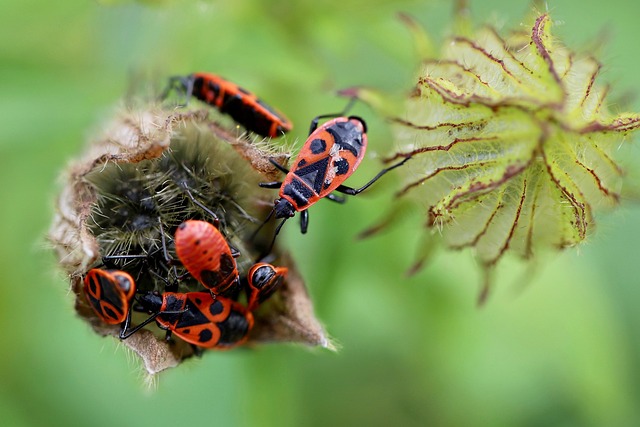Boxelder bugs (Boisea trivittata) have distinct seasonal patterns, with females laying eggs in spring, a summer generation, and dormancy in winter. Effective pest control involves monitoring signs like swarms, tracking egg masses, and sealing entry points. Strategic prevention includes regular inspections, sealing windows/doors, lawn maintenance, and cleaning up leaves to reduce breeding grounds. Year-round measures like insecticidal soap deter infestations, creating a comfortable living environment. For existing issues, professional services offer targeted treatments while homeowners can vacuum bugs and maintain cleanliness.
“Unraveling the seasonal mysteries of boxelder bugs is crucial for any homeowner aiming to prevent pesky infestations. This comprehensive guide navigates the life cycles and patterns of these insects, offering insights into their behavior throughout the year. From understanding their breeding seasons to identifying signs of an impending invasion, we equip you with knowledge. Additionally, discover effective pest control methods and preventative measures to keep your space bug-free. Prepare for boxelder bug season with our expert tips on combating these critters.”
Understanding Boxelder Bug Life Cycles & Seasonal Patterns
Boxelder bugs (Boisea trivittata) exhibit distinct seasonal patterns, understanding which is crucial for effective pest control. Their life cycle follows a typical insect development, beginning as eggs laid by females on suitable hosts, primarily boxelder trees or other maple species. These eggs hatch into nymphs, which undergo several molts before transforming into adults. The timing of these developmental stages varies with the season.
In spring, nymphs become mature, and this marks the beginning of their active season. Adults are most noticeable during this time due to their high mobility as they seek new feeding grounds. As summer progresses, boxelder bugs settle down to lay eggs, starting a new generation. The second generation typically emerges in late summer or early fall, continuing the pest control challenges until cold weather sets in. During winter, these bugs enter dormancy, often seeking refuge in warm, protected areas, which makes them less active and easier to manage.
Identifying and Monitoring Boxelder Bug Infestations
Identifying and monitoring boxelder bug infestations is a crucial step in effective pest control for boxelder bugs. These insects, characterized by their distinctive red or orange dots along their backs, often appear in large numbers during specific seasons. Homeowners should keep an eye out for telltale signs such as swarms of bugs gathering on windowsills, walls, or outdoor lights. Regular inspections, especially in the late summer and early fall, can help detect infestations at an early stage.
Monitoring involves tracking their activity and life cycle. Look for egg masses, typically found on tree branches or under eaves, which can indicate an imminent infestation. As these bugs are attracted to sunlight, observing their behavior near windows or doors can provide valuable insights into the extent of the problem. Prompt action is key; regular monitoring enables homeowners to implement targeted pest control measures before the population grows out of control.
Effective Pest Control Methods for Boxelder Bugs
Boxelder bugs, known for their seasonal invasions, require a strategic approach to pest control. Effective methods involve a multi-pronged strategy, starting with prevention. Seal entry points around windows and doors, as these insects often enter homes during fall and winter. Regularly inspecting your property for any signs of infestation is crucial, enabling early intervention.
When dealing with an existing issue, professional pest control services offer the most reliable solution. They employ targeted treatments using insecticides that specifically target boxelder bugs while minimizing environmental impact. For homeowners, regular vacuuming can help remove adult bugs and eggs, breaking the life cycle. Additionally, maintaining a clean environment by promptly addressing fallen leaves and debris reduces potential breeding grounds.
Preventative Measures to Prepare for Boxelder Bug Season
Preparing for boxelder bug season involves a combination of preventative measures and proactive strategies. One of the first steps in pest control for boxelder bugs is to ensure your home and property are well-maintained. Regularly inspecting and sealing entry points, such as cracks in foundations, gaps around windows and doors, or openings in screens, can significantly reduce their access into your living space. Additionally, keeping your lawn mowed and removing any debris or stacked wood nearby can deprive these pests of hiding places and food sources.
Implementing a year-round pest control plan is another effective strategy. This includes maintaining a clean environment by promptly cleaning up fallen leaves and twigs where boxelder bugs reproduce. Applying preventive treatments, like insecticidal soap or oil, to vulnerable areas during the warmer months can also deter these bugs from settling in. By taking these proactive steps, you can minimize the impact of boxelder bug infestations and create a more comfortable living space for both yourself and your family.
Boxelder bugs are a seasonal nuisance, but with proper preparation and knowledge of their life cycles, you can effectively manage and prevent infestations. Understanding their seasonal patterns allows homeowners to implement preventative measures like sealing entry points and maintaining a clean environment. For existing infestations, a combination of non-toxic methods, such as sticky traps and plant oils, offers a safe and eco-friendly approach to pest control for boxelder bugs. By combining monitoring, control, and prevention strategies, folks can minimize the impact of these bugs and keep their homes comfortable year-round.
